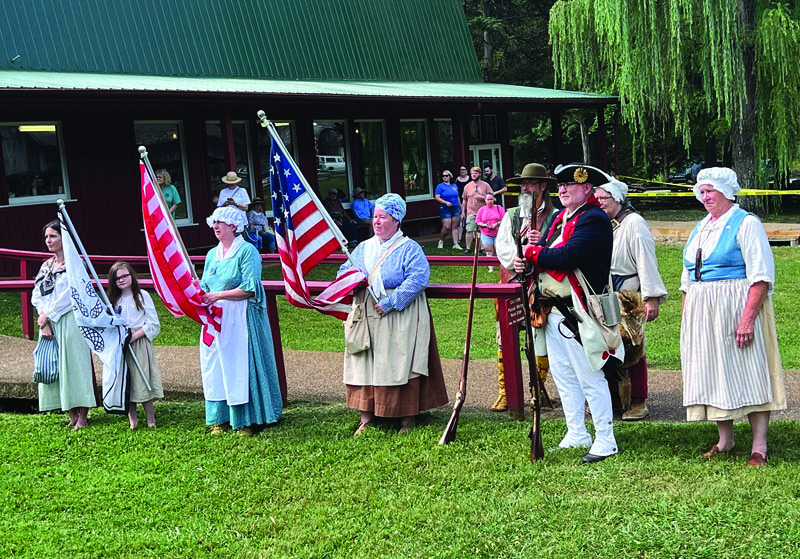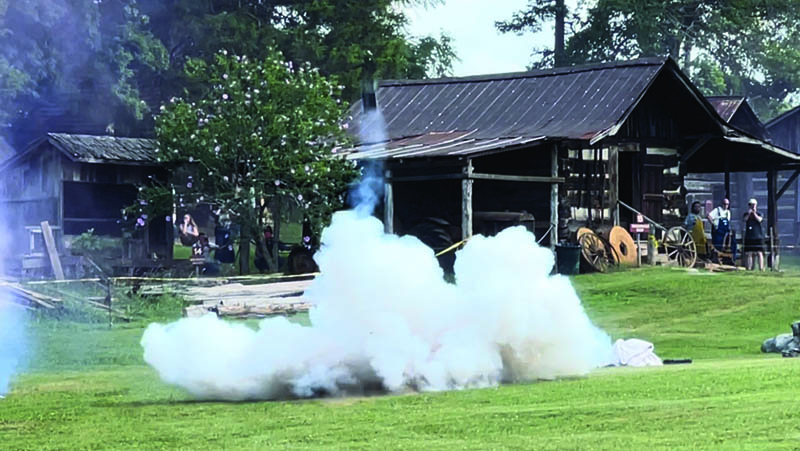Anvil shoot, processions mark July 4
A daylong series of hourly “anvil shoots” with their accompanying big booms, along with processions of Revolutionary War troops helped the Museum of Appalachia once again put on a full slate of activities celebrating America’s Independence Day last Thursday.
Crowds were thick most of the day, especially when the anvil was shot into the air by a huge charge of gunpower each hour in the museum’s special version of July 4 “fireworks.”
People lined up along a rope set up at a safe distance from the anvil shoot site for each blast, as gunpowder was set off inside the top of one anvil to blast another, sitting on top of it, more than 200 feet straight up into the air.
A brisk breeze blowing during the 11 a.m. shoot seemed to have no effect on the trajectory of the 200-pound anvil.
But the blast itself was loud enough to startle the crowd – and most likely anyone up to at least a quarter-mile away. As the anvil rose to its arc, then began dropping back to earth in the large field behind the museum’s main building, the crowd broke out into cheers.
Men dressed as Revolutionary soldiers and women wearing attire of the same period marched in a procession waving flags through the museum grounds several times during the day, with the men carrying replica firearms of that period of American history.
Both events are highlights of July 4 activities each year at the museum on Andersonville Highway in Norris.
“Anvil shoots were once a common way for pioneers to commemorate holidays, elections and other special occasions,” the museum says on its website.
Other activities included a bell-ringing ceremony, live music, Southern food, and demonstrations of Appalachian and pioneer-type activities by blacksmiths, beekeepers, dulcimer makers, spinners, weavers, rail splitters and more.
The Museum of Appalachia, at 2819 Andersonville Highway, bills itself as “A Living Mountain Village,” and is an associate of the Smithsonian Institution in Washington, D.C.
According to its website:
“The Museum of Appalachia, founded in 1969 by John Rice Irwin, portrays an authentic mountain farm and pioneer village, with some three-dozen historic log structures, several exhibit buildings filled with thousands of authentic Appalachian artifacts, multiple gardens and free range farm animals, all set in a picturesque venue and surrounded by split-rail fences. There are over 250,000 artifacts housed in three multi-story exhibit buildings; vast collections of folk art, musical instruments, baskets, quilts, Native American artifacts, and much more.
“This unique collection of pioneer buildings and artifacts was amassed over half a century by John Rice Irwin. He traveled back roads and collected thousands of everyday items from the colorful mountain folk of Southern Appalachia.
“Today, the museum focuses on the preservation of its massive collection and the development of educational programs to enhance its mission to inform and entertain visitors while preserving the past for the future,” the website notes.




